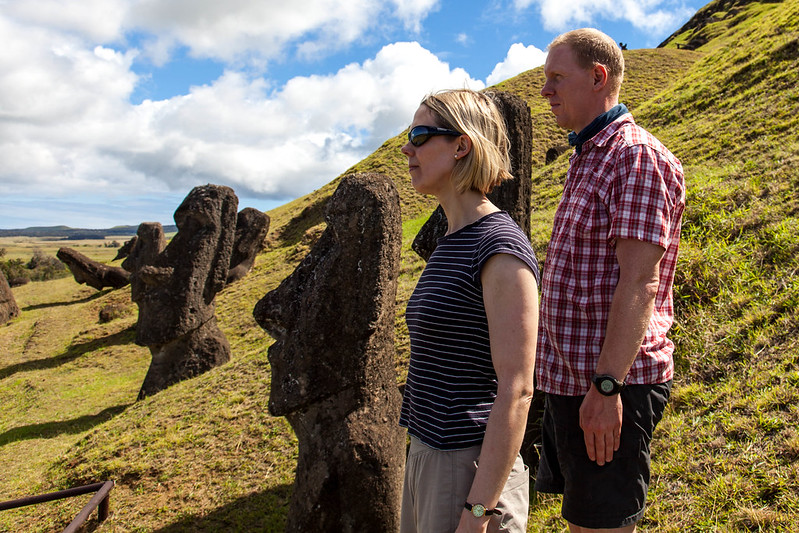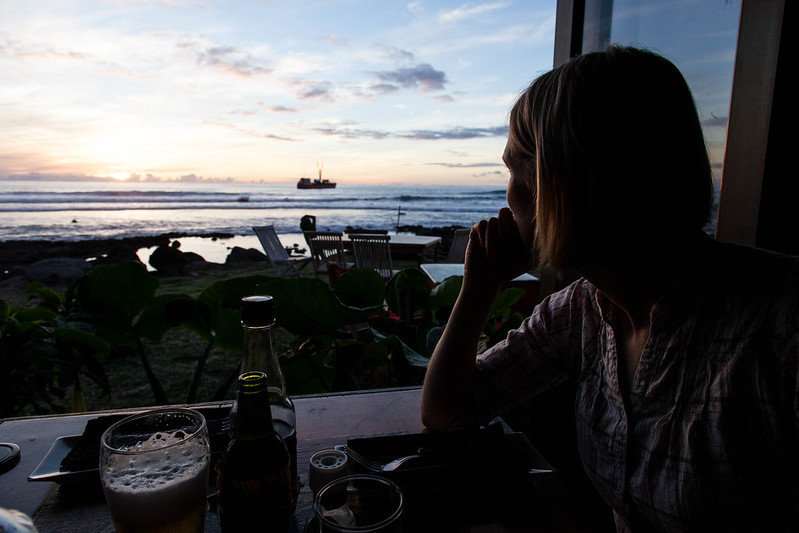 Flying for five hours off the coast of Chile and expecting to find an airstrip somehow felt improbable, as we boarded the plane for Easter Island on Monday morning. Finding it by canoe from an unknown part of Polynesia seems even less likely. Given that Easter Island is little more than twenty kilometres long and located over a thousand miles from Chile (to the East) and Pitcairn Island (to the West), the words 'needle in a haystack' spring to mind, but somehow a Polynesian canoe managed to thread it around fifteen hundred years ago. And they turned it into quite some needle!
Flying for five hours off the coast of Chile and expecting to find an airstrip somehow felt improbable, as we boarded the plane for Easter Island on Monday morning. Finding it by canoe from an unknown part of Polynesia seems even less likely. Given that Easter Island is little more than twenty kilometres long and located over a thousand miles from Chile (to the East) and Pitcairn Island (to the West), the words 'needle in a haystack' spring to mind, but somehow a Polynesian canoe managed to thread it around fifteen hundred years ago. And they turned it into quite some needle! |
| Moai near Hanga Roa |
First stop was a set of Moai just north of Hanga Roa (Easter Island's only town). The Moai are the iconic stone figures dotted all around the island, representing the islanders' ancestors and serving as objects of worship, to protect them from harm. Like all Moai, they looked landwards, across the island, with their weathered faces, vacant eyes, and resilient majesty. We snapped our first few dozen photographs, not quite realising how many zillion more would be needed over the next few days. (Charge up those batteries; they'll be needed!)
But first, it was time to become vocal fans of the local tipple, Pisco Sour (add mango for the best effect, yuuumm) and sit by the ocean in our t-shirts eating amazing sea food. Who needs to climb mountains? This is the life!
 |
| Easter Island sunset |
The next day we took a tour of many of the main Moai sites on the island. The first couple featured the Moai statues lying broken, face down on the dark volcanic rocks of the shore. Why? Apparently, as natural resources declined, including agricultural products and timber for building canoes, the islanders decided that the gods weren't doing a great job of protecting them and toppled them. Captain Cook reported as much when he visited the island, although he didn't make a long stop here. Finding sources for information about the culture of the island is incredibly difficult, to say we are dealing with events only a few hundred years ago. Take it as read that 'they think', 'apparently', 'so far as we know', 'this is how one theory goes' etc. etc. accompany most sentences here.
 |
| Toppled Moai |
Later in the morning we visited the inland quarry where the statues were carved out of the rock. I found it the most impressive of all the sites we visited but archeological and historical problems came even thicker and faster here than elsewhere. Why were there several hundred Moai in production in the quarry at the time when this form of worship ceased, given that only a couple of hundred finished Moai had been installed in the preceding millennium? And how did Moia over twenty metres high make it from the quarry down to the shore without the help of the mighty petrol engine? Anyone with a passion for turning over theories of transportation (ranging from wooden rollers to UFOs) should make their way here sharpish!
 |
| Ranu Raraku: birthplace of the Moai |
As much as anything, we loved the range of styles of the different Moai; many rooted in the quarry had thinner figures with sharper facial features than their more rounded counterparts on the coast. Such characteristics must of course be photographed! Time to reach for the cameras. And again. And just one more. Got it? Yes. Oh, change of light. Better take it again ...
 |
| Tongariki (from Ranu Raraku) |
With groaning memory cards, we made it back down to the coast to a couple of sites where once-toppled Moai had been re-erected to stand overlooking the bay in their former glory. One exception was the figure washed about fifty metres inland by a tsunami. There are tsunami warning signs dotted around the island directing you where to go if the sea decides it's time for an almighty clean-out (upwards, towards higher ground, being the general gist). Guy decided at this point to start calculating the probability of a tsunami taking place during our visit until I pointed out that we will be spending the next three months travelling along a massive tectonic plate boundary and this probably isn't the moment to get nervous about it.
 |
| Just another Rapa Nui sunset |
At the last site of the day, the Moai had to compete with a few other distractions: namely, a sandy beach and a beer tent. We nonetheless paid them homage first, but our cameras got off relatively lightly before it was bikini time and then beer time. Take ten on the words 'this is the life'. The evening brought take eleven (Pisco Sour), take twelve (an amazing fish dinner courtesy of Te Moana), take thirteen (watching surfers at sunset), take fourteen (a nice Chilean white) and so on and so on. (Trying to make the readers jealous? Me? Never.)
Daylight hours seem rather strangely timed here; the sun rises around 8:30am and sets about twelve hours later. Breakfasts are generally late and leisurely as a result, but on our third day we got up at the ungodly hour of 7am to catch sunrise at Tongariki - one of the most impressive sites we had visited the day before. We hitched a lift with our next door neighbours at the hotel and stepped onto the deserted beach around 7:45. By about 7:50, we discovered that several hundred other tourists had had the same idea. With our mountaineering hats on, we've got used to secluded places and become proprietorial about our vistas, but over the last couple of days we've had to adjust to the idea that you can't have such impressive sights to yourself! When the sun hit the sides of the row of figures, it was of course worth both the early wake-up call and the crowd.
Next stop was the top of one of the volcanoes, which has a huge crater lake with a lip opening onto the sea. On its upper slopes there is a village that was inhabited for just a few weeks a year in the final few centuries of undisturbed Easter Island life, before us brutal westerners got our hands on the place. By the time the village was built, the Gods had had their day and this village was used for the annual ceremony associated with the Bird Man cult; the young and strong (and male, of course) raced down the volcano, swam to an island and collected the first bird eggs of the season, in a bid to give their tribe the rule of the island for a year. In the rain, and without a guide, we probably got less out of this site than we should have done but we spent some time in the evening reading up its history. We also learned more about the later (grimmer) centuries of island life after western ships suddenly emerged on the horizon after a millennium of isolation. (Capturing the locals to serve as slaves, carrying them to Peru, introducing smallpox - that kind of spread of 'civilisation' - is, unfortunately, all part of the tale and makes for harrowing reading.)
Our time on Easter Island was running out fast at this point so we went for a final swim, a final beer on the beach (I plead innocent of all beer-drinking of course; it's disgusting stuff!) and a final Pisco-fish-wine-sunset combo. Guy somehow managed to convince me that the toilets in this particular restaurant were so beautifully decorated with flowers that I simply couldn't miss them (how did I fall for this?) and, in my absence, he asked the waitress to bring me a birthday pudding with candles. I don't think I've had as good a round of birthday applause in a restaurant since I was a student! Well, if you have to get a year older, Easter Island's a pretty good place to do it.
After a final breakfast of mango, banana, eggs and pancakes, and a quick trip to the museum, it was time for reality to hit and Santiago to appear again below the wings of LAN airlines. Big sigh, accompanied by culture shock extraordinaire. Easter Island may be a long way to travel for a few days but it's amazing; go there.



What exactly is a Pisco Sour? It sounds great!
ReplyDeleteIt's the drink Susan has in her hands in the older blog post. Basically the local liqueur with lime and egg white, chilled! Will try to bring a bottle back in the summer! V. yummy!
ReplyDeleteThe information you've provided here is fantastic because it provides a wealth of information that is really useful to me. Thank you for sharing that. travel portal development cost online
ReplyDeleteThis data which you have shared here, It's a beneficial and useful article. I want to urge you to at last proceed with your incredible work. I'm much happy to you. Online Car Rental Booking Sites
ReplyDeleteThis information is meaningful and magnificent which you have shared here about the I am impressed by the details that you have shared in this post and It reveals how nicely you understand this subject. I would like to thanks for sharing this article here. Holidays in British Virgin Islands
ReplyDeleteVery interesting. Your article is so convincing that I can never stop myself from saying anything about it. You are doing a great job, thanks for sharing such a great blog. Cost Of Andaman Tour Package
ReplyDeleteVery well written article. It was an awesome article to read. about Valley Of Flowers Complete rich content and fully informative. I totally Loved it.
ReplyDeleteVery Good information, this information is excellent and very important for everyone. I am very very thankful to you for providing this kind of information.
ReplyDeletethings to do in st maarten
I am heartily thankful to you that you have shared important and essential information with us. I got some different kind of knowledge from your webpage, and it is very much important for everyone. Thanks online travel agency website development
ReplyDeleteThe information you've provided here is fantastic because it provides a wealth of information that is really useful to me. Thank you for sharing about things to do in Denver in this blog.
ReplyDeleteYou have done good work by publishing this article here.Best Resort Near Pune I found this article too much informative, and also it is beneficial to enhance our knowledge. Grateful to you for sharing an article like this.
ReplyDeleteThis accessible new "passport card" may be used to enter the United States legally from our surrounding nations, including Bermuda and the Caribbean, Mexico, and Canada. Only land, sea, or border crossings will be permitted to use this card as a passport. Other forms of air travel will not be allowed. Quick passport
ReplyDelete